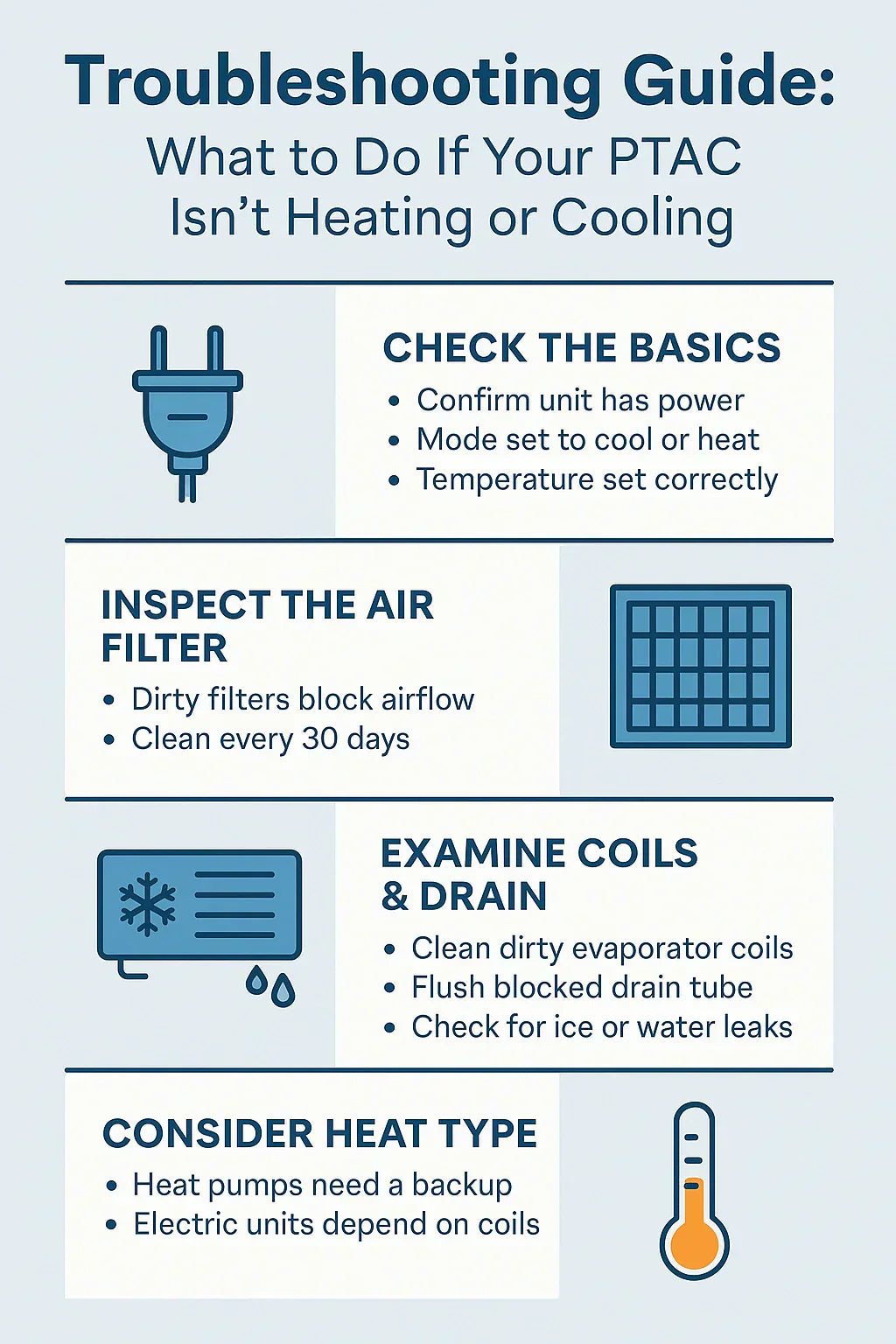📌 Introduction: Don’t Panic — PTAC Issues Are Common
There’s nothing worse than turning on your PTAC unit on a sweltering day (or a freezing night) and realizing it’s blowing the wrong air — or none at all.
The good news? Most PTAC issues are minor and easy to fix if you know what to look for.
In this guide, I’ll walk you through a step-by-step troubleshooting process to help you figure out:
-
Why your PTAC isn’t cooling or heating
-
What you can fix yourself
-
When it’s time to call a pro
🔌 1. Start with the Basics
Before diving into complex fixes, check the simple stuff:
-
Power Supply: Is the unit plugged in and switched on?
-
Breaker Panel: Reset any tripped circuit breakers.
-
Mode Setting: Confirm it’s set to Cool in summer or Heat in winter.
-
Temperature Setting: Make sure the thermostat is set lower than room temp (for cooling) or higher (for heating).
👉 More tips from ENERGY STAR – Room AC Guide.
🧽 2. Check the Air Filter
-
Problem: Clogged filters block airflow, making the unit seem like it’s not working.
-
Fix: Remove, wash with warm water, and dry before reinstalling.
-
Frequency: Every 30–60 days.
❄️ 3. Inspect the Coils
-
Problem: Dirty evaporator or condenser coils reduce efficiency.
-
Fix:
-
Turn off the unit.
-
Gently vacuum or brush coils.
-
Use a non-corrosive coil cleaner if needed.
-
-
Tip: Do this twice yearly — spring and fall.
👉 Learn more at U.S. DOE – AC Maintenance.
💧 4. Look for Drainage Issues
-
Problem: Blocked drains cause water buildup → can shut down cooling or heating.
-
Fix:
-
Check the drain pan for standing water.
-
Flush the drain tube with water + vinegar solution.
-
Ensure the sleeve has a slight outward tilt for drainage.
-
👉 Guide from – PTAC Maintenance.
🌡️ 5. Heat Pump vs. Electric Heat Problems
Heat Pump PTAC
-
Issue: Not heating in freezing temps
-
Fix: Heat pumps lose efficiency below ~35°F → rely on backup electric coils.
Electric Resistance PTAC
-
Issue: No heat despite being on
-
Fix: Check for tripped breakers; heating elements may need replacement.
👉 More on heat pumps at Consumer Reports – Heating & Cooling.
🔧 6. Check the Thermostat & Controls
-
Problem: Thermostat sensor misreading room temp.
-
Fix:
-
Reset the PTAC by unplugging it for 5 minutes.
-
Ensure nothing is blocking airflow around the thermostat sensor.
-
🏠 7. Noise, Smells & Other Warning Signs
-
Unusual Rattling → Loose sleeve or mounting issue
-
Burning Smell → Dust on heating elements; turn off and clean
-
Clicking or Buzzing → Electrical relay issue; call a pro
⚠️ 8. When to Call a Professional
-
Repeated breaker trips
-
Refrigerant leaks (oily residue or weak cooling)
-
Electrical issues (sparks, burning smells)
-
Compressor or fan motor failure
👉 Find certified help via HVAC.com – Find a Pro.
📊 Quick Fix Checklist
| Problem | DIY Fix | Call a Pro When… |
|---|---|---|
| Unit won’t turn on | Check breaker & plug | Breaker keeps tripping |
| No airflow | Clean/replace filter | Still blocked after cleaning |
| Weak cooling/heating | Clean coils, check drains | Refrigerant or compressor issues |
| Water leaking | Clear drain tube, tilt sleeve | Water damage persists |
| Strange noise/smell | Tighten sleeve, clean unit | Electrical/burning odors |
💡 Jake’s Pro Tips
-
Keep a Maintenance Log: Note filter cleaning and coil care dates.
-
Set Calendar Reminders: Monthly for filters, seasonal for coils.
-
Have a Backup Heater or Fan: Just in case your PTAC needs repairs.
-
Don’t Ignore Small Issues: Rattles or leaks usually get worse.
-
Invest in OEM Parts: Filters and sleeves from your PTAC brand last longer.
📌 Conclusion: Most PTAC Problems Are Fixable
A PTAC that isn’t heating or cooling doesn’t always mean disaster.
-
Start with filters, coils, and drains.
-
Check thermostat settings and power supply.
-
Know the difference between heat pump vs. electric heat issues.
-
Call a pro for refrigerant leaks or electrical problems.
💡 Jake’s Takeaway: With regular care and quick troubleshooting, your PTAC can run efficiently for 10+ years without major repairs.
In the next topic we will read more about: Do PTAC Units Qualify for Energy Rebates or Tax Credits in 2025?







